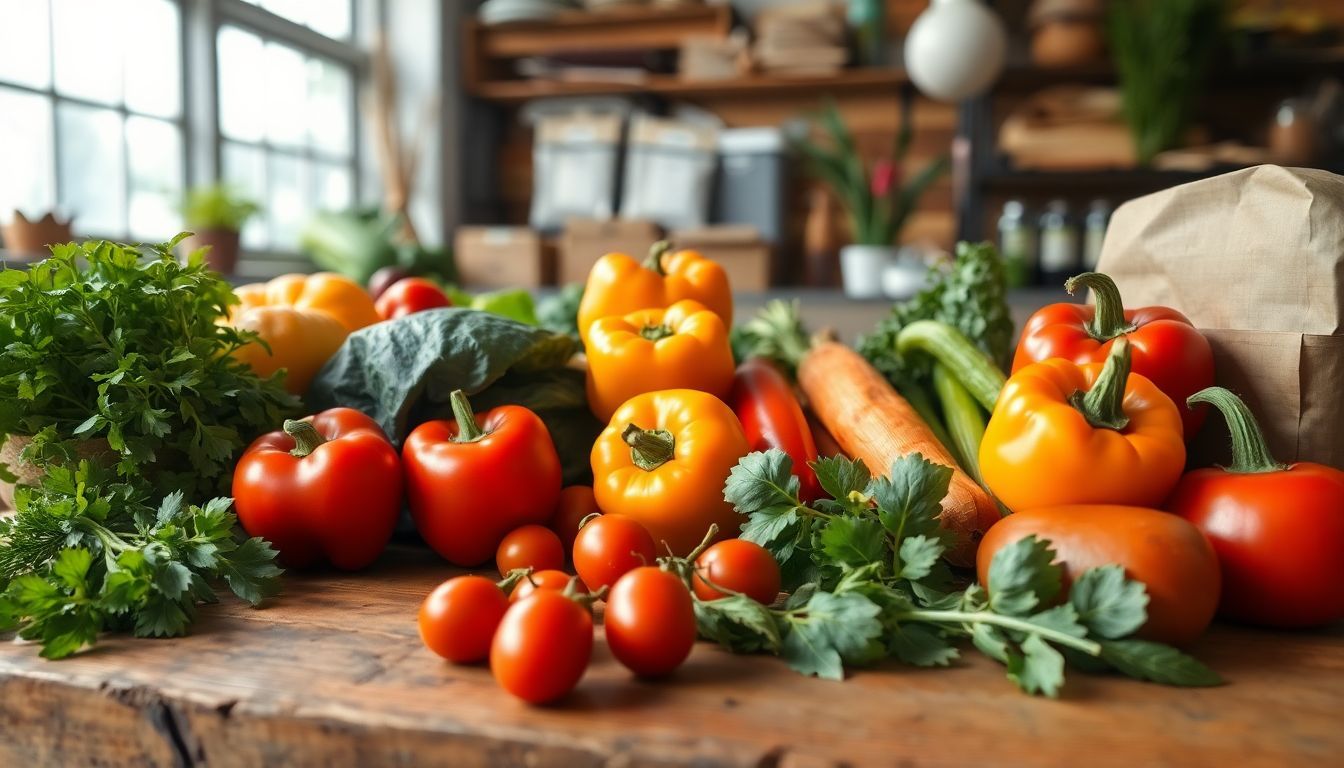Struggling to make meals that are healthy and tasty? Soup can be your perfect solution—it’s comforting, filling, and packed with nutrients. From tomato soup to chicken noodle soup, this blog will show you how to boost flavors while keeping it nutritious.
Thank you for reading this post, don't forget to subscribe!Get ready for easy tips to transform your soups into satisfying meals!
Key Takeaways
- Use a veggie-rich broth with low-sodium options (140–200 mg per serving) and add colorful vegetables for nutrients and flavor. Whole grains like barley or brown rice increase fiber and filling power.
- Fresh herbs such as basil, thyme, or parsley enhance taste and nutrition. Global seasonings like miso paste, turmeric, or coconut milk add unique flavors to soups.
- Blend roasted vegetables or use plant-based milks like coconut or oat milk for creamy texture without heavy cream. Greek yogurt also adds richness with extra protein.
- Add lentils, beans, squash, or potatoes to make soups hearty and satisfying while boosting nutritional value with protein and fiber.
- Top your soup with toasted nuts/seeds for crunch or dollops of yogurt/pesto for depth in flavor while keeping it healthy and exciting!
Building a Nutritious Soup Base
A good soup starts with a healthy base. Focus on ingredients that boost nutrients and add natural flavors.
Start with a veggie-rich broth
Start with a base of low-sodium vegetable stock. Aim for 140–200 mg of sodium per serving to keep it heart-healthy. Add colorful vegetables like tomatoes, carrots, celery, and onions to pack in vitamins and antioxidants.
They give your soup flavor and help boost nutrition.
Enhance the broth using tomato paste or cheese rinds for umami depth. Toss in herbs like dill or thyme, peppercorns, or kosher salt for balance. This veggie-rich start lays the groundwork for adding whole grains next!
Add whole grains for extra fiber
Mix in whole grains like barley, farro, or brown rice to boost fiber. They add texture and prebiotics that support gut health. Pearled grains such as farro and barley cook faster but still pack nutrition.
These options are more filling than refined grains.
The Dietary Guidelines for Americans suggest making at least 50% of your grain intake whole grains. Whole wheat is richer in protein, fiber, and vitamins than white bread or pasta.
Try these ingredients in soups like minestrone soup or chicken soup for added benefits….
Creative Ways to Enhance Flavor
Fresh ingredients make all the difference in boosting your soup’s taste. A little creativity with spices and unique seasonings can transform any recipe into something unforgettable.
Use fresh herbs and spices
Fresh herbs and spices can transform your soup into something extraordinary. They boost flavor and add extra nutrition to your meal.
- Add basil, parsley, or oregano to tomato soup for a classic taste. These herbs complement the rich acidity of tomatoes.
- Sprinkle thyme in French onion soup or potato leek soup for a subtle earthy twist. Thyme pairs well with caramelized onions and creamy textures.
- Use smoked paprika or dried chiles for a savory kick in lentil soup or minestrone soup. These warm spices create depth without overwhelming the dish.
- Toss fresh parsley on butternut squash soup just before serving for brightness and color contrast. Parsley also offers antioxidants and vitamins like A and C.
- Experiment with global flavors like cilantro in Thai soups or miso paste mixed with scallions for Korean-inspired bowls. Lime juice alongside these adds a tangy balance.
- Enhance heartier soups like sausage-tortellini by seasoning with rosemary or sage during cooking—perfect for comforting fall meals.
- Mix chipotles in adobo sauce into bean-based soups like locro for smokey spiciness, ideal for weight loss-friendly recipes without heavy calories.
Herbs don’t just season—they highlight natural ingredients beautifully!

Experiment with international seasonings
Switching up your herbs and spices is just the start. Reach for seasonings like miso paste from Japan or shrimp paste found in Southeast Asian dishes to transform your soup into something exciting.
Add a bit of lime juice to brighten hearty curries or sprinkle cumin for warm, earthy tones.
A small splash of coconut milk can turn tomato soup into a creamy, Thai-inspired delight. Ash reshteh—an Iranian herb-packed noodle soup—is another way to explore bold flavors while still keeping things nutritious.
A squeeze of citrus or dash of vinegar can balance out richness with just the right amount of acidity.
Spice Up Your Dinner: Add Global Flavors to Your Meals
Try Indian Vegetable Soup with turmeric, cumin, and ginger. These spices add warmth and depth while boosting nutrition facts. Add a squeeze of lime juice for brightness.
Create a Peruvian twist with hearty legumes like lentils in your soup. Use cilantro, garlic, and caramelized onions to mix vibrant flavors. Toss in rotisserie chicken for protein and balance.
Mediterranean soups like Caldo Verde bring earthy tastes from kale and potatoes. Use coconut oil instead of olive oil for a new layer of flavor—a light yet bold update to this comforting recipe!
Making Soups Creamy Without Cream
You don’t need heavy cream to make a soup rich and smooth. Simple ingredients like blended veggies or plant-based milks can work wonders… and taste amazing!
Blend vegetables for a silky texture
Pureeing cooked vegetables turns soup into creamy comfort food. Use tools like an immersion blender, traditional blender, or food processor to get the perfect smoothness. Carrots, butternut squash, and potatoes work great for this method.
Roasting veggies first boosts flavor before blending. Add a splash of lime juice or vinegar for brightness after pureeing. For extra richness in low-calorie soups, mix in plain yogurt or coconut milk too!
Incorporate plant-based milk alternatives
Coconut milk works wonders for creamy soups like butternut squash soup or tomato soup. It adds richness without dairy and pairs well with spices like curry or lime juice. Oat milk offers a smoother taste—its beta-glucan helps lower cholesterol, making it perfect for health-focused low-calorie soup recipes.
Soy milk is another great option, especially in miso or minestrone soup. With protein levels similar to cow’s milk, it boosts nutrition while staying vegan-friendly. Blending different plant-based milks can balance flavors and nutrients—try combining soy and coconut cream for variety.
Adding Texture and Substance
A good soup has more than just flavor—it should feel satisfying too. Add hearty ingredients to make every spoonful filling and enjoyable.
Include legumes like lentils or beans
Lentils and beans make soups hearty and healthy. They are rich in protein, fiber, iron, and folate. Lentil soup is a comforting option packed with nutrients while being low-calorie.
Beans like black beans or chickpeas add texture and boost flavor to any recipe.
These legumes thicken soups naturally without cream. Blend some for a smooth texture or leave them whole for variety. They’re also perfect for meal prep—store leftovers in the fridge or freezer for later use.
Add them to tomato soup or minestrone soup for extra substance!
Toss in hearty vegetables like squash or potatoes
Squash and potatoes make soups hearty. Add 4 cups of butternut squash and 2 cups of diced potatoes to your pot. They thicken the broth and add a rich texture. For creamy potato soup, use 1.5 pounds of Yukon gold potatoes and mix in white beans for protein.
Simmering these veggies with broth releases deep flavors. Cook them for about 30 minutes until tender. These ingredients work great in minestrone soup or butternut squash soup recipes! Keep reading to learn how toppings can elevate your bowl even more….

Topping Off Your Soup
A good topping can make soup more exciting. Add layers of flavor and texture for a satisfying meal.
Use toasted seeds or nuts for crunch
Toasted seeds and nuts can transform soups like tomato soup or butternut squash soup. They add a satisfying crunch and boost the flavor. Sprinkle roasted pumpkin seeds on creamy soup or miso soup for contrast.
Almond slivers pair well with potato leek soup, while toasted walnuts elevate lentil soup.
These toppings aren’t just tasty—they’re healthy too. Nuts are rich in fiber, protein, and good fats. Seeds like sunflower or sesame bring extra nutrients to low-calorie soups without piling on calories.
Toast them lightly in coconut oil for more depth of flavor!
Add a dollop of yogurt or pesto for richness
A spoonful of yogurt adds silky texture to any tomato soup or lentil soup. It brings creaminess without extra fat from heavy cream. Greek yogurt works best because it’s thicker and packed with protein.
Pesto, especially red pesto, boosts flavor instantly. Stir in a dollop for richness in minestrone soup or butternut squash soup. Don’t have pesto? Try curry paste or dried herbs—they’re flavorful swaps that are easy to find.
Conclusion
Soup is more than just comfort food—it’s a bowl of possibilities. You can make it rich, creamy, or light and brothy while packing in nutrients. With simple tweaks like fresh herbs, coconut milk, or hearty grains, soup becomes a satisfying meal.
Try new ingredients and toppings to keep it fun and flavorful. Grab your spoon… your next favorite recipe might be simmering!
For more inspiration on bringing a world of taste to your table, check out how to spice up your dinner with global flavors.
